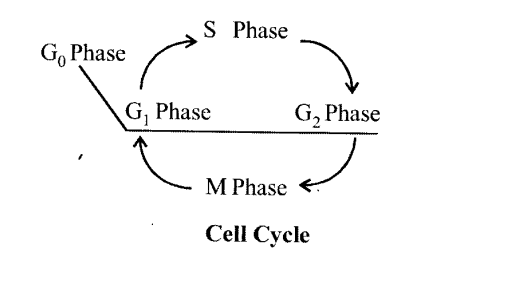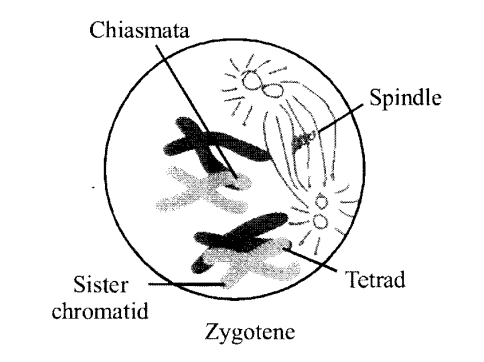NCERT Solved Exercise Questions – Class 11 Biology Chapter 10 Cell Cycle and Cell Division
10.1 What is the average cell cycle span for a mammalian cell?
Ans – It is crucial to note that cell division proper only lasts for about an hour of the usual 24-hour cell cycle of a human cell or mammalian cell.
10.2 Distinguish cytokinesis from karyokinesis.
Ans – 1. Cytokinesis is a division of the cytoplasm, whereas karyokinesis is a division of the nucleus (mitosis or meiosis).
2. A furrow forms in the plasma membrane as a result of cytokinesis in animal cells.
3. The furrow steadily deepens and eventually unites in the middle, severing the cytoplasm of the cell in half.
4. In-plant cell cell wall development begins in the cell’s middle and spreads outward to meet the lateral walls already present.
5. A simple precursor known as the cell plate, which stands in for the middle lamella between the walls of two adjacent cells, is formed before the development of a new cell wall.
6. Organelles like mitochondria and plastids are dispersed between the two daughter cells during the cytoplasmic division stage.
7. In some organisms, cytokinesis is not immediately followed by karyokinesis, which results in a multinucleate state and the development of syncytium (liquid endosperm of coconut).
10.3 Describe the events taking place during interphase.
Ans – Despite being referred to as the resting phase, the interphase is metabolically extremely active. It is the period of time when the cell gets ready to divide by going through regulated processes of DNA replication and cell expansion. Three additional phases follow the interphase:
- G1 phase (Gap)
- S phase (Synthesis)
- G2 phase (Gap2)
The transitional period between mitosis and the start of DNA replication is known as the G1 phase. The cell is metabolically active and continues to develop during the G1 phase but does not duplicate its DNA. The time when DNA synthesis or replication occurs is known as the “S” phase. The amount of DNA in each cell doubles throughout this period. DNA increases from 2C to 4C if the initial amount is indicated. However, the number of chromosomes does not increase; if the cell had diploid or 2n chromosomes at G1, the number of chromosomes continues to be 2n even after the S phase.
As DNA replication starts in the nucleus of animal cells during the S phase, centrioles start replication in the cytoplasm.
10.4 What is Go (quiescent phase) of cell cycle?
Ans – The G0 phase occurs when the cell cycle is inactivated because mitogens and substances with high levels of energy are not present. In this stage, cells are still metabolically active but no longer proliferate, meaning they do not expand or differentiate unless required to do so by the organism. For instance, chordate heart and nerve cells are permanently in the G0 phase.

10.5 Why is mitosis called equational division?
Ans – The most dramatic stage of the cell cycle, known as the M phase, involves a significant restructuring of almost all cell parts. It is also known as equational division since both the parent and progeny cells have the same number of chromosomes. Although mitosis has been conveniently divided into four stages of nuclear division, it is crucial to realise that cell division is a progressive process, and very clear distinctions between different stages cannot be made.
Following are the four stages of mitosis:
- Prophase
- Meta phase
- Anaphase
- Telophase
10.6 Name the stage of cell cycle at which one of the following events occur:
(i) Chromosomes are moved to spindle equator.
(ii) Centromere splits and chromatids separate.
(iii) Pairing between homologous chromosomes takes place. (iv) Crossing over between homologous chromosomes takes place.
Ans – (i) Metaphase
(ii) Anaphase
(iii) Zygotene of prophase I of the meiosis 1
(iv) Pachytene of prophase I of the meiosis I
10.7 Describe the following:
(a) synapsis
(b) bivalent
(c) chiasmata Draw a diagram to illustrate your answer.
Ans – (a) Synapsis: Homologous chromosomes begin partnering up during the zygotene of prophase I stage, and this process of association is known as synapsis. According to electron micrographs of this stage, synaptonemal complex, a complex structure, is formed together with chromosome synapsis.

(b) Bivalent: A bivalent, also known as a tetrad, is a complex made up of a pair of synapsed homologous chromosomes, also known as four chromatids or a pair of chromosomes.

(c) Chiasmata: The breakdown of the synaptonemal complex and the propensity of the synapsed homologous chromosomes of the bivalents to split from one another, save at the sites of crossovers, serve as markers for the onset of diplotene. Chiasmata are X-shaped structures that serve as points of connection between homologous chromosomes.
10.8 How does cytokinesis in plant cells differ from that in animal cells?
Ans – When cytokinesis occurs in animal cells, the plasma membrane develops a furrow. The cytoplasm of the cell is split in half by the furrow, which eventually merges in the centre.
Plants have a distinct cytokinesis because they have cell walls. In plants, wall production begins in the cell’s middle and spreads outward to meet the lateral walls that already exist. The basic precursor known as the cell plate, which symbolises the middle lamella between the walls of two adjacent cells, is formed before the new cell wall can be fully formed. During this procedure, organelles including mitochondria and plastids are dispersed between the two daughter cells.
10.9 Find examples where the four daughter cells from meiosis are equal in size and where they are found unequal in size.
Ans – The four daughter cells produced during meiosis during the development of male gametes (i.e., spermatozoa) in a typical mammal (i.e., a human being) are all of the same size. However, the size of the four daughter cells varies when a female gamete (i.e., an ovum) develops in a normal mammal (i.e., a human).
10.10 Distinguish anaphase of mitosis from anaphase I of meiosis.
Ans –
The main difference between anaphase of mitosis and anaphase I of meiosis
The shortest phase of mitosis is called the anaphase. Anaphase-promoting complex (APC) formation occurs. Proteins that bind the two chromatids in the centromere region start to degrade. Each chromosome’s centromere splits as a result. As a result, the two chromatids are transformed into daughter chromosomes, each of which is connected to the spindle pole of its respective side by a separate chromosomal fibre. The centromeres and limbs of the chromosomes all protrude toward the spindle poles as they travel in that direction. Chromosome fibres also become shorter in a similar manner. Interzonal fibres keep the two poleward travelling chromosomes of each type connected to one another. In the end, two chromosomal groups settle at the spindle poles.

Chiasmata entirely vanish during meiosis’ first anaphase, and homologous chromosomes split. The action is referred to as disjunction. The divided chromosomes (univalents), also known as dyads, exhibit divergent chromatids. Two groups of haploid chromosomes are eventually formed as they move in the direction of the spindle poles.

10.11 List the main differences between mitosis and meiosis.
Ans –

10.12 What is the significance of meiosis?
Ans – Following is a list of meiosis’s significance:
(i) Gamete formation – Meiosis creates gametes, which are necessary for sexual reproduction.
(ii) Genetic information – It turns on the genetic information necessary for the production of gametes or gametophytes while turning off the genetic information necessary for sporophytic life.
(iii) Chromosome number maintenance – Meiosis reduces the number of chromosomes in sexually reproducing organisms to keep it constant. Since the number of chromosomes doubles after fertilisation, it is crucial.
(iv) Chromosome assort – During meiosis, paternal and maternal chromosomes independently assort. The chromosomes’ control over traits is rearranged as a result. The variances aid breeders in developing valuable plant and animal races.
(v) Crossing over: It brings together new qualities or variations.
(vi) Mutations – Improper meiotic divisions might result in chromosomal and genomic mutations. Natural selection keeps some of these mutations alive because they are advantageous to the organism.
(vii) Proof of the fundamental kinship between organisms – The fact that the majority of organisms share essentially identical meiosis details demonstrates their fundamental kinship.
10.13 Discuss with your teacher about
(i) haploid insects and lower plants where cell-division occurs, and
(ii) some haploid cells in higher plants where cell-division does not occur.
Ans – (i) In haploid insects like honey bee drones and lower plants like gametophytes of algae, bryophytes, and pteridophytes, cell division occurs.
(ii) Synergids and antipodals are haploid cells that do not undergo cell division and are found in the embryo sac of the ovule.
10.14 Can there be mitosis without DNA replication in ‘S’ phase?
Ans – The time when DNA synthesis or replication occurs is known as the “S” phase. The amount of DNA in each cell doubles throughout this period. DNA increases from 2C to 4C if the initial amount is indicated. However, the number of chromosomes does not increase; if the cell had diploid or 2n chromosomes at G, the number of chromosomes is still 2n even after the S phase.
10.15 Can there be DNA replication without cell division?
Ans – Replication of DNA occurs to get cells ready to divide. The logical stage after DNA replication is cell division.
10.16 Analyse the events during every stage of cell cycle and notice how the following two parameters change
(i) number of chromosomes (N) per cell
(ii) amount of DNA content (C) per cell
Ans – During the cell cycle’s S-phase and anaphase, the number of chromosomes and the amount of DNA alter. The time when DNA synthesis or replication occurs is known as the “S” phase. The amount of DNA in each cell doubles throughout this period. DNA increases from 2C to 4C if the initial amount is indicated. The number of chromosomes does not, however, grow; if the cell had 2N or diploid chromosomes at G„, even after S phase, the number of chromosomes remained the same, i.e., 2N.
The number of chromosomes stays the same during mitotic anaphase. Only sister chromatids travel in the direction of their respective poles. The amount of DNA is unaffected. Chromosome numbers are cut in half, from 2N to IN, and DNA content is decreased by 50%, from 4C to 2C, during meiotic anaphase I. Meiosis II’s anaphase II sees a 50% reduction in DNA content from 2C to 1C while maintaining the same number of chromosomes.




